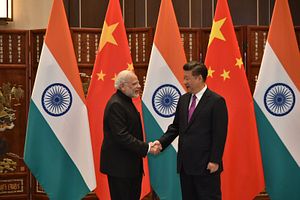The April 28 meeting of Indian Prime Minister Narendra Modi and Chinese President Xi Jinping at Wuhan has been described by some as a “reset” in bilateral relations between India and China. The informal meeting was a welcome move to end the diplomatic estrangement resulting from the standoff at Doklam last year.
Such a “reset” mode might be useful in carrying forward the dialogue process of the Bangladesh-China-India-Myanmar Forum for Regional Cooperation (BCIM). Connecting the two greatest markets in Asia under a single platform is expected to help in linking more underdeveloped markets in Asia. BCIM is also expected to lead to rational allocation of resources with common benefits to the region. Together the BCIM region accounts for 9 percent of the world’s total landmass and 40 percent of its population. The combined population of India’s Northeast, China’s Yunnan province, Bangladesh, and Myanmar is 440 million. Among the four members, China represents 14.8 percent of the world economy and India 2.83 percent.
To date, India has been reluctant to attach itself to China’s Belt and Road Initiative (BRI). Part of this hesitance is rooted in concerns about Chinese intentions and the possibility of misusing the BRI as geostrategic leverage against India. India has also refused to be part of the BRI plan due to involvement of China in Pakistan, particularly in the China-Pakistan Economic Corridor (CPEC) which transgresses Indian-claimed but Pakistan-occupied Kashmir.
However, in the BCIM project, India is on board.
India is centrally positioned in South Asia and is one of the world’s strongest economies. India’s presence is an added opportunity to improve connectivity and increase business between South, Southeast and East Asia.
At the heart of the BCIM initiative is a route connecting Kolkata with Kunming which will cross the countries of Bangladesh and Myanmar. The main focus of the corridor is to facilitate trade and connectivity between the underdeveloped and landlocked part of northeastern India and Southwestern China. The proposed 2,800 km long economic corridor will traverse from Kolkata via Benapole/Petrapole on the India-Bangladesh border to Dhaka and Sylhet before again entering India near Silchar in Assam. Crossing through Imphal in Manipur it moves to the Tamu-Kalewa friendship road in Myanmar. After crossing Mandalay and Lashio the road will reach Kunming via Ruili, Longling and Dali.
BCIM Corridor provides the opportunity to all four countries to exploit trade complementarities. China is one of the leading manufacturing countries of the world, while India excels in service sector exports. Myanmar is a primary goods exporter and has abundant cheap labor. Bangladesh is engaged in low-end manufactured goods especially garments and clothing. The countries involved are expected to gain from greater market access for goods, services, and energy trade. The elimination of non-tariff barriers and tariff barriers along with development of value and supply chains based on comparative advantage can transform the entire region.
BCIM can also play effective role in the energy trade and in the development of tourism. The energy trade is feasible in the region as the southwestern provinces of China (Sichuan, Guizhou, and Yunnan), the northeastern states of India, Yadana, and the Shwe gas fields in Myanmar, all have large reserves of natural gas. In addition, this subregion has rich reserves of coal, petroleum, and manganese. The region also has substantial water resources that could be employed in generating hydroelectricity to accelerate the industrial sector.
As far as tourism is concerned, the BCIM region is dotted with a number of tourist destinations which not only showcase beautiful landscapes but also a wide range of cultural diversity. Apart from facilitating easy travel and hassle-free visas among the members, the countries can also develop religious tourism circuit.
India should take the opportunity to boost the BCIM forum. India should be a proactive player in the forum for its own benefit. India’s participation in the project is important as the project has important benefits for the development of India’s northeast. India should not miss out on the opportunities generated by BCIM, especially in light of China’s bilateral connectivity projects around the region. The China-Myanmar corridor will be Y-shaped corridor, which will start from China’s Yunnan province and go towards Mandalay in Myanmar. After reaching Mandalay, the corridor could extend to Yangon city and towards the Kyaukphyu SEZ in Rakhine state.
There is also the idea of a China-Nepal corridor in which India would be a partner. However, as of now, India is yet to publicly declare its stand on the project.
India’s participation in BCIM becomes all the more important to engage constructively with China and ensure that it is not isolated in the region.
Saheli Bose is a PhD research scholar at the School of International Studies, Jawaharlal Nehru University, New Delhi.
































